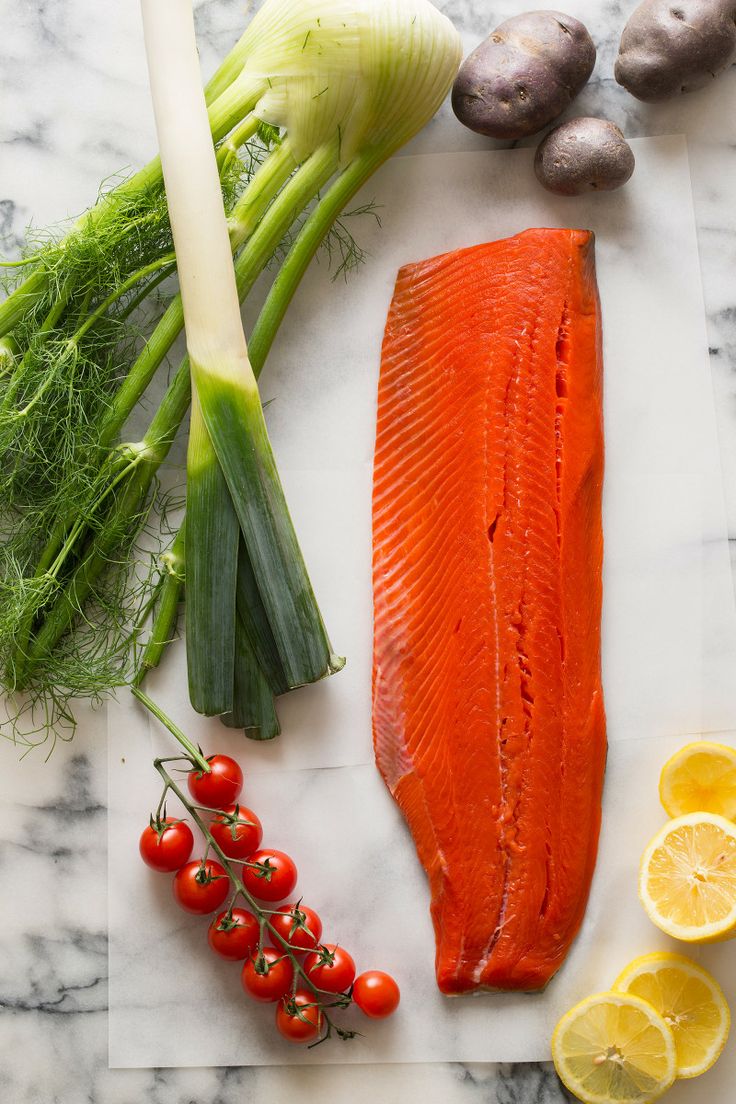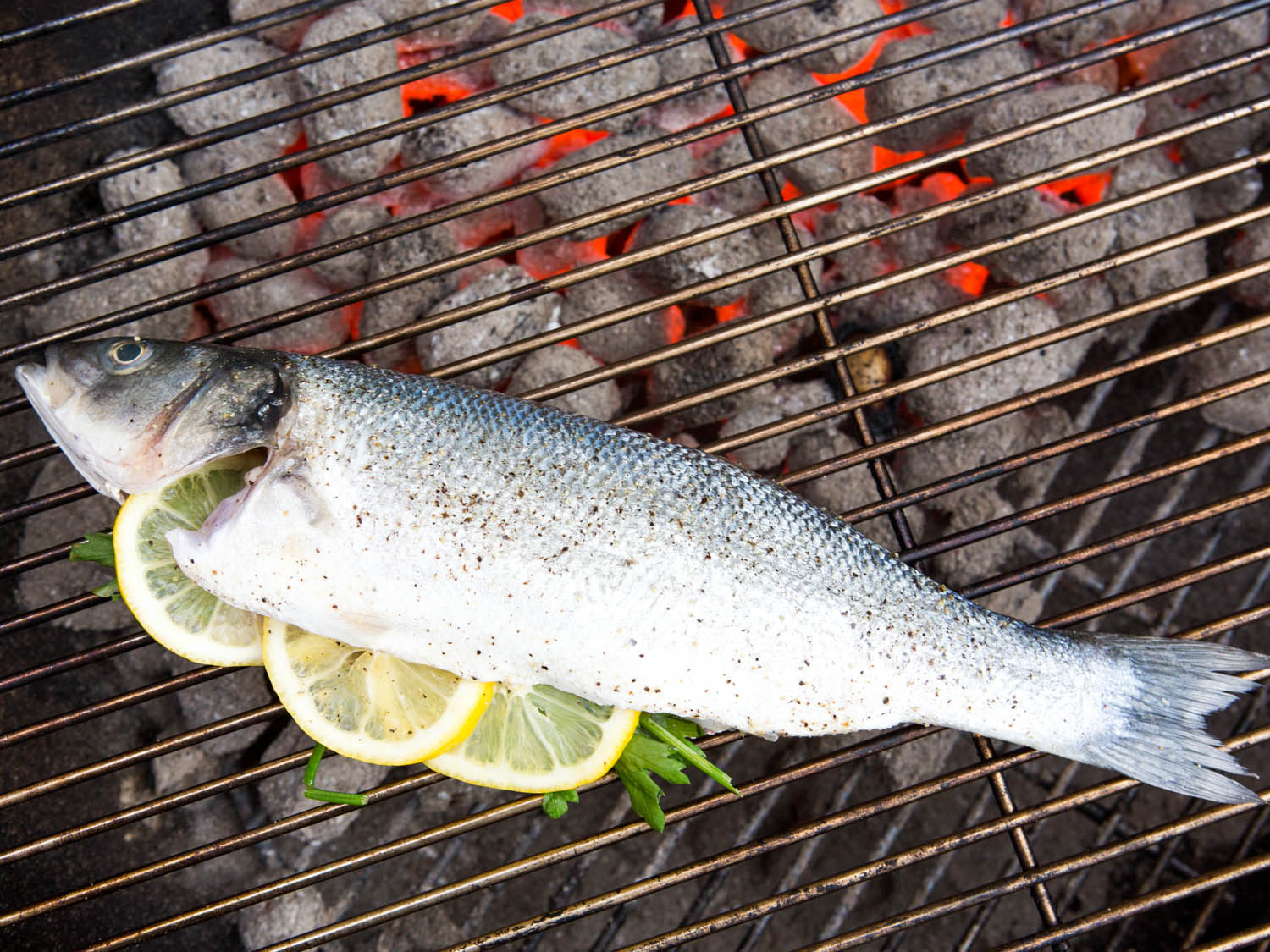
In a test of fish bought in 24 states and the District of Columbia, Oceana found consumers weren't getting what they paid for.
If you order a filet of snapper at a restaurant, you probably expect to be served snapper. But a new report suggests there's a strong chance you'll be getting something else.

Oceana, a marine conservation nonprofit with a recent history of studying seafood mislabeling, today published a new report on the state of seafood fraud in the U.S. They found that 20 percent of the 449 fish they tested were incorrectly labeled.
Orders of sea bass were often replaced by giant perch, Alaskan halibut by Greenland turbot, and Florida snapper by lavender jobfish, to name a few. Oceana made headlines in 2016 by publishing a report finding massive seafood fraud on a global scale.
 [photo source and recipe for “Stacked” Side of Salmon]
[photo source and recipe for “Stacked” Side of Salmon]
Since then, NOAA created the Seafood Import Monitoring Program (SIMP), to track 13 species deemed at high risk of being fraudulently sold or sourced illegally.
None of the 13 SIMP monitored species were sampled. “We wanted to highlight that there are other species other than the high-risk species,” says Kimberly Warner, a senior scientist at Oceana and one of the report's authors.
 [photo source and recipe for Lemon Garlic Salmon]
[photo source and recipe for Lemon Garlic Salmon]
To get a snapshot of how widespread the issue is, Oceana's employees and volunteers took fish samples from 24 different states and the District of Columbia.
Fish came from restaurants, seafood markets, and large grocery stores. Samples were then sent to a lab where DNA was analyzed.
 [photo source and recipe for Roasted Barramundi with Meyer Lemon Vinegarette]
[photo source and recipe for Roasted Barramundi with Meyer Lemon Vinegarette]
Sea bass and snapper were the most commonly mislabeled species, and fish ordered at restaurants were more likely to be mislabeled than fish bought at markets or grocery stores.
Mislabeling also occurred when cheaper, imported fish were sold as local catch and when farm-raised fish were marketed as wild caught. “What we saw is that we still have a problem,” says Warner. “It's a concern for everyone who eats seafood.”
 [photo source and recipe for Lemon-Herb Baked Trout]
[photo source and recipe for Lemon-Herb Baked Trout]
A widespread issue….
A 2013 Oceana study sampled more species and found mislabeling happened at a higher rate, 33 percent. The environmental group is one of many organizations looking at mislabeling.
Last December, the New York state attorney general issued a report on “disturbingly” high rates of fraud in New York supermarkets. It found that one in four fish sampled were mislabeled. Cheaper, less desirable fish were often sold in the name of more popular fish.
 [photo source and recipe for Grouper with Grilled Oranges and Onions]
[photo source and recipe for Grouper with Grilled Oranges and Onions]
Particularly concerning was the report's finding that some substitutes were fish that contain higher mercury levels or come from less sustainable fisheries.
Last September, a crab vendor in Virginia pleaded guilty to conspiring to pass off foreign crab meat as Atlantic blue crab.
 [photo source and recipe for Pan Fried Cod w/Citrus Basil butter Sauce]
[photo source and recipe for Pan Fried Cod w/Citrus Basil butter Sauce]
Local news reports alleged more than 180 tons of falsely labeled crab meat was sold at large grocery chains like Harris Teeter.
In 2017, a study published in the journal Conservation Biology by researchers at the University of California, Los Angeles found that half the sushi sold in L.A. restaurants was actually not what was listed on the menu.
 [photo source and recipe for Fish Stuffed with Herbs, Walnuts and Pomegranate]
[photo source and recipe for Fish Stuffed with Herbs, Walnuts and Pomegranate]
Marine ecologist Erin Spencer recently received a National Geographic Society grant to study how widely red snapper is mislabeled in southeastern U.S. states.
She took samples sold at seafood markets, grocery stores, and sushi restaurants from North Carolina to Florida and found that most of her samples were not labeled correctly. Some of that may stem from confusion or miscommunication, she notes.
 [photo source with 20 flounder recipes]
[photo source with 20 flounder recipes]
“Part of that is because the FDA says there's only one species that can be called red snapper, but there are lots of other snappers that are red in color,” she says, noting that many species beyond snapper look similar, especially when cooked.
She also notes that red snapper is both commercially sold and recreationally fished, making it a coveted species.

Though she wasn't involved in the Oceana study, she says the group's findings are consistent with her own research. Why does it matter? Not knowing what fish is on your plate may present a health risk, says Warner.
Catfish farm-raised in Asia, for instance, isn't subjected to the same chemical and handling regulations as domestically sourced catfish.
 [photo source and recipe for grilled salmon w/Blueberry Sauce]
[photo source and recipe for grilled salmon w/Blueberry Sauce]
“You’re exposing your family to unknown risks from a health perspective,” she adds. Of the seafood consumed in the U.S., more than 90 percent is imported.
In some cases of seafood fraud, consumers trying to support local fishers were instead served fish from a foreign country.
 [photo source and recipe for Crab Stuffed Flounder]
[photo source and recipe for Crab Stuffed Flounder]
In Chicago, one commonly fished Great Lake species is the walleye. But instead of walleye, tests showed some consumers were served a freshwater species called zander commonly found in Europe and Asia.
“There’s a huge movement to eat sustainable seafood and as a consumer you’re trying to make really informed decisions,” says Spencer. “That only works if the fish are what they say they are.” Understanding why a fish was mislabeled is difficult to quantify, Warner notes.
 [photo source and info on how to grill fish]
[photo source and info on how to grill fish]
Confusion of labeling laws, using common vernacular, or misidentifying a fish all likely contribute to some of the fish that are mislabeled.
“What we found time and again is most often what is substituted is something of less value,” she says, providing an economic incentive for illegally substituting fish.
 [photo source and recipe for Grilled Indian Fish]
[photo source and recipe for Grilled Indian Fish]
Can we fix it?
The U.S.'s SIMP tracking program ends at the border—once the imported fish enters the U.S. it has little oversight. Warner says mislabeling is happening throughout the supply chain, but pinpointing exactly where is information they are still searching for.
In their report, the environmental group states: “Oceana recommends that all seafood—both domestic and imported—must be tracked from the fishing boat or farm to the plate.”
 [photo source with recipe for grilled red snapper]
[photo source with recipe for grilled red snapper]
In Europe, where nearly a third of all seafood was once mislabeled, stricter labeling laws and consumer awareness has made that rate drop to just four percent. A number of groups and companies in the U.S. are trying to build out similar end-to-end tracking supply chains.
For consumers who want to ensure they aren't eating mislabeled seafood, Spencer recommends learning more about where a fish is sourced, saying, “Take the time to learn what fish are in season in your area."
 article coped word for word from an article I ran across on on NationalGeographic.com
article coped word for word from an article I ran across on on NationalGeographic.com
you might also wanna check out…….
My 10 Highest Lowest (and 10 Highest) Mercury Seafoods
(….including info for pregnant women)
click here or photo below
check out all my articles in
"Eat Smart", the science of food
(click here or on the photo below) Copyright Disclaimer: Right to use photos claimed under: Section 107 of the Copyright Act 1976, allowance is made for fair use for purposes such as criticism, comment, news reporting, teaching, scholarship, and research. Fair use is a use permitted by copyright statute that might otherwise be infringing. Non-profit, educational or personal use tips the balance in favor of fair use.
Copyright Disclaimer: Right to use photos claimed under: Section 107 of the Copyright Act 1976, allowance is made for fair use for purposes such as criticism, comment, news reporting, teaching, scholarship, and research. Fair use is a use permitted by copyright statute that might otherwise be infringing. Non-profit, educational or personal use tips the balance in favor of fair use.

























































































Leave Your Response